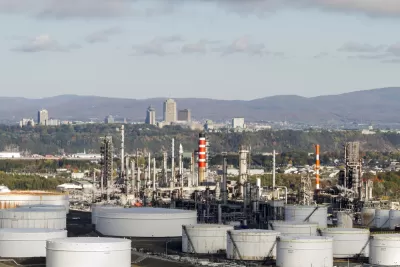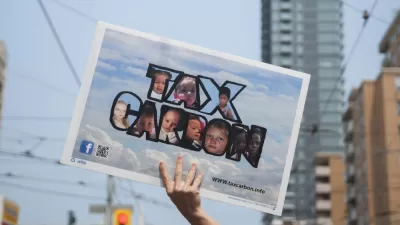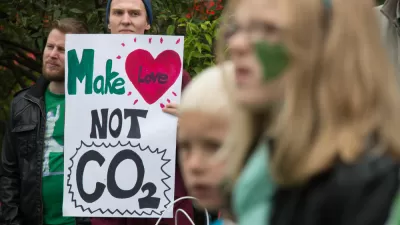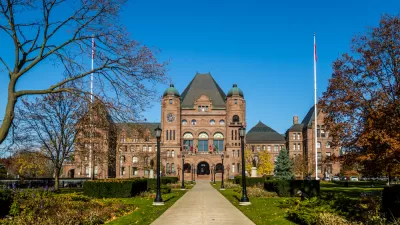A carbon tax-and-dividend plan goes into effect on January 1 in the four Canadian provinces that don't price carbon emissions. Revenues will be rebated to residents, small businesses, and public institutions as Climate Action Incentive payments.

Two weeks after a dire climate change report was released by a prestigious U.N. panel and a Nobel Prize in economics was awarded to William Nordhaus for his work on taxing carbon emissions, Prime Minister Justin Trudeau announced a plan on Tuesday to take effect January 1 that will price carbon emissions in the four Canadian provinces that lack a carbon pricing plan, be it a carbon tax or cap-and-trade program.
"Starting next year, it will no longer be free to pollute anywhere in Canada," Trudeau told CBC News. "And we're also going to help Canadians adjust to this new reality ... Every nickel will be invested in Canadians in the province or territory where it was raised."
"The plan will apply to Ontario, Saskatchewan, Manitoba and New Brunswick," report Josh Wingrove and Greg Quinn for Bloomberg News. Ontario Premier Doug Ford, elected on June 7, ended his province's participation in the Western Climate Initiative with California and Quebec, estimated to cost the province $3 billion.
The baseline price on carbon will be C$20 [U.S.$15.38] per metric tonne initially, rising to C$50 [U.S.$38.44] by 2022.
Note that last year, British Columbia increased its carbon tax by $5 per metric ton each year, reaching $50 per metric ton in April 2021.
The charge on large industrial emitters will begin in January, though revenue details have yet to finalized, while the fuel tax will take effect in April.
Revenues rebated
Unlike a similar, though unsuccessful, Washington state carbon tax-and-dividend measure, Initiative 732 in 2016, 90 percent of the revenue from Trudeau's plan "will be sent out as benefits to individuals, and the government projects that the average household will receive more in rebates than it pays in the tax, and the rest to cities, small businesses, and institutions like schools," add Wingrove and Quinn.
The rebates will be called Climate Action Incentive payments. According to the Global News video, the payments will be in the forms of checks sent to Canadians' mailboxes.
Of course, the amount residents pay in the new fuel charge rates depends on how much they drive and the fuel efficiency of their vehicle. "The C$20 per tonne initial charge is the equivalent of 4.42 Canadian cents per liter on gasoline," note Wingrove and Quinn, the equivalent of 12.19 U.S. cents per gallon if this correspondent did his math correctly.
Will that modest increase create the incentive noted in the second bullet below in the Canada Department of Finance's "Quick Facts on carbon pollution pricing"?
- Carbon pollution pricing is the most effective and efficient way to reduce the greenhouse gas emissions associated with climate change.
- Carbon pollution pricing delivers economic benefits because it encourages Canadians and businesses to innovate, and to invest in clean technologies and long-term growth opportunities that will position Canada for success in a cleaner and greener global economy.
- Once in place, carbon pollution pricing could cut Canada's greenhouse gas emissions by 50 to 60 million tonnes in 2022.
In any case, according to the Bloomberg reporters, most Canadian families will come out ahead:
The average household cost of the plan will range from C$202 to C$403 annually starting in 2019, depending on the province, while the average household rebate will range from C$248 to C$598.
Energy Intensive Trade Exposed industries
According to the American Council for an Energy-Efficient Economy, a prevalent concern with climate change legislation among industries and lawmakers with industrial constituents is that it will increase energy costs and potentially compromise the global competitiveness of what are called "energy-intensive, trade-exposed" (EITE) industries.
The carbon fee initiative known as I-1631, to be decided by Washington state voters on Nov.6, already the most expensive ballot measure in the state's history, deals with EITEs by granting exemptions, which provided fodder for the opponents, the oil and gas industry.
Trudeau's plan implements a "so-called output-based pricing system, or OBPS, that allows policymakers to reduce risks for high-emitting industries and those that are trade exposed," reports Wingrove in a separate article on Oct. 23. Businesses are awaiting the details.
One way or another, the system will set a cap that will be a windfall for some firms, which could sell credits, and a tax for others.
Political landscape
As with all taxes, even those that are rebated, they are inherently political.
"Trudeau’s plan fires a salvo into what is one of Canada’s top political battles right now -- whether to have a carbon tax," adds Wingrove.
It largely pits Trudeau’s Liberals, and other left-leaning parties, against the countries prominent conservatives, including federal Conservative Leader Andrew Scheer, who has criticized Trudeau for going easy on industrial emitters, and Ontario Premier Doug Ford, who is vowing to fight the plan.
For more on how the politics play out, watch this Global News video.
Related in Planetizen:
-
Deciding the Price of Canada's Carbon, October 24, 2016Prime Minister Justin Trudeau aims to institute a national carbon price in Canada.
Hat tip to Citizens' Climate Lobby via John Holtzclaw.
FULL STORY: Trudeau Imposes Carbon Tax, With Rebates, on Four Provinces

Alabama: Trump Terminates Settlements for Black Communities Harmed By Raw Sewage
Trump deemed the landmark civil rights agreement “illegal DEI and environmental justice policy.”

Planetizen Federal Action Tracker
A weekly monitor of how Trump’s orders and actions are impacting planners and planning in America.

The 120 Year Old Tiny Home Villages That Sheltered San Francisco’s Earthquake Refugees
More than a century ago, San Francisco mobilized to house thousands of residents displaced by the 1906 earthquake. Could their strategy offer a model for the present?

Opinion: California’s SB 79 Would Improve Housing Affordability and Transit Access
A proposed bill would legalize transit-oriented development statewide.

Record Temperatures Prompt Push for Environmental Justice Bills
Nevada legislators are proposing laws that would mandate heat mitigation measures to protect residents from the impacts of extreme heat.

Downtown Pittsburgh Set to Gain 1,300 New Housing Units
Pittsburgh’s office buildings, many of which date back to the early 20th century, are prime candidates for conversion to housing.
Urban Design for Planners 1: Software Tools
This six-course series explores essential urban design concepts using open source software and equips planners with the tools they need to participate fully in the urban design process.
Planning for Universal Design
Learn the tools for implementing Universal Design in planning regulations.
Clanton & Associates, Inc.
Jessamine County Fiscal Court
Institute for Housing and Urban Development Studies (IHS)
City of Grandview
Harvard GSD Executive Education
Toledo-Lucas County Plan Commissions
Salt Lake City
NYU Wagner Graduate School of Public Service





























